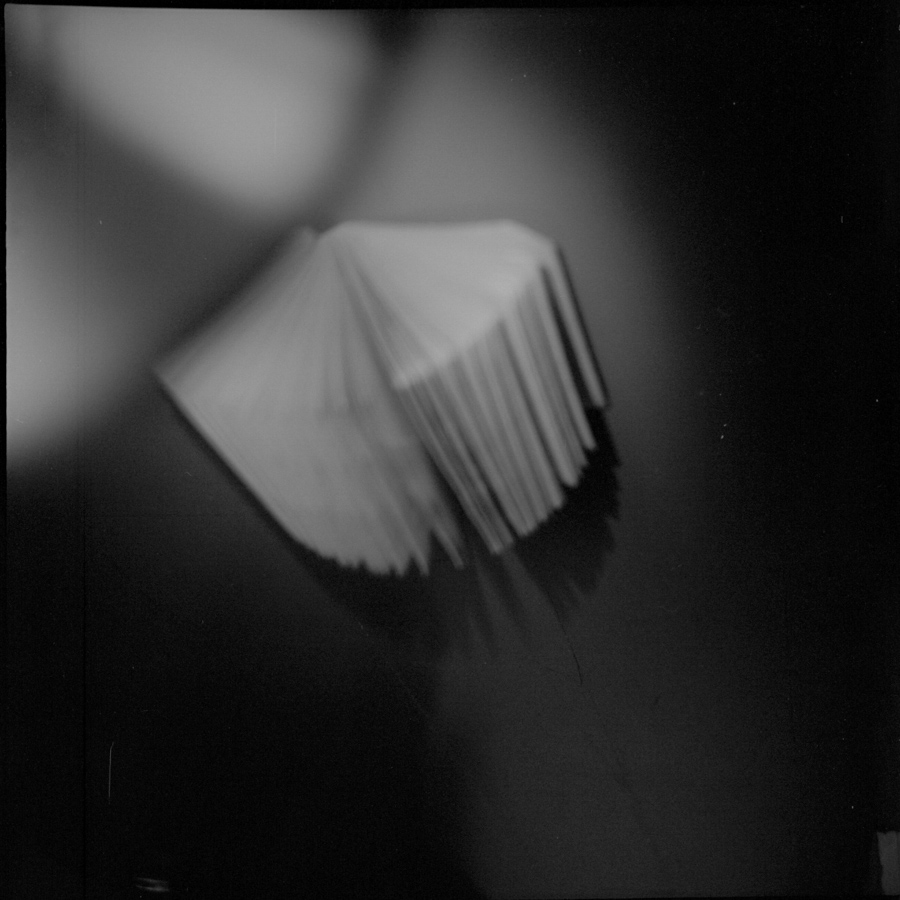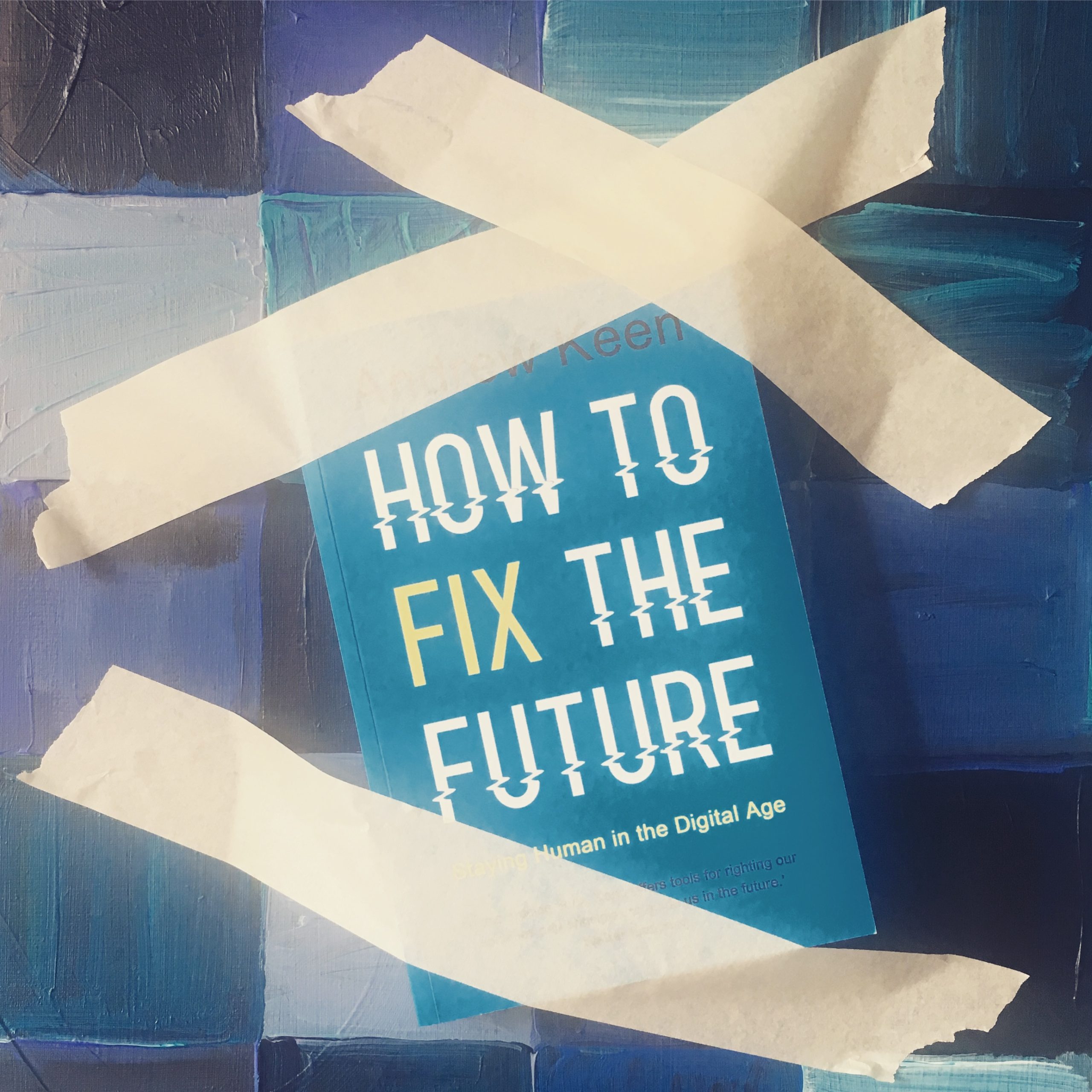A new year gives the perfect opportunity to reflect on the way your life and work are unfolding. Start your year off right with a creative retrospective.
Very Human Gods: An Interview with Manjari Sharma
Manjari Sharma is an artist originally born in India but living for the last 20 years in the United States. Her works travel topics and styles, from deeply personal studies of her parents to fantastical scenes of Hindu gods and goddesses, from straight documentary to the conceptual and multimedia. Whatever her subject, coursing through her work is unflinching humanism. Sharma brings out the human aspects of gods, and the divine of humans. In this interview, we speak about the ambivalence of good and evil, the importance of guarding your creative flame, and how becoming a mother changed her creative practice.
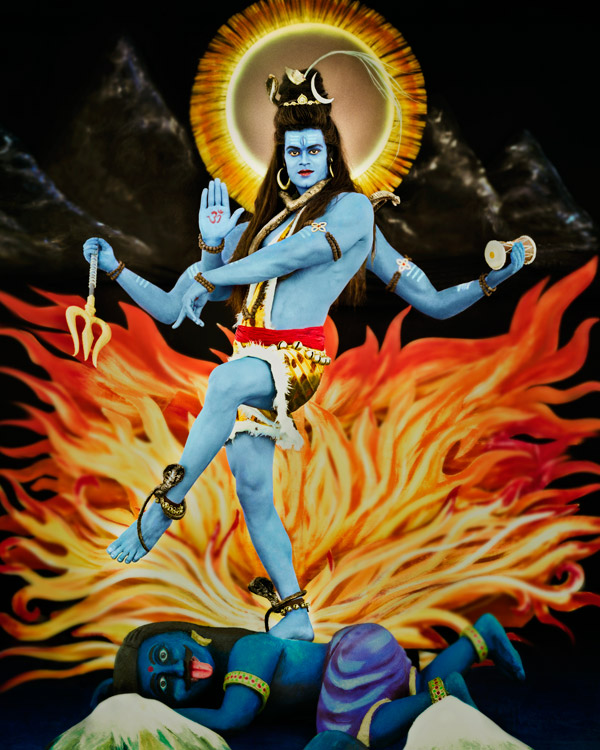
Your series Darshan portrays nine Hindu gods and goddesses in fantastical elaborate settings to convey their mythologies. What do these stories mean to you?
I really love human beings but they can be such monsters, too. They’re both, but I really have faith in our balance of good over evil. Ultimately, I think these stories repeat that message in one form or another, over and over again: there’s good and there’s bad, and the good can appear to be failing but it will eventually overcome. You might hear a story and think, “Oh no, it’s all over!” but then there’s a reincarnation and a rise again. You can’t eradicate the bad, but if good doesn’t give up then the balance can be maintained.
That to me is inspiring because I feel like every day is made up of those decisions: Good or bad, good or bad? If you take too many bad ones you start drowning in them, you know? It’s the conversation between ethics and morals and responsibilities and karma. It all comes down to karma. What are you doing with the time that you have here? I feel like these stories remind you of that. There are also great examples of what happens when you don’t do it right. Look at what we did to Sita, and what she had to experience because we judge women.
What is Sita’s story?
That’s such a sad story. Sita is the wife of Rama, who is the picture of ultimate morality. She gets kidnapped and taken away by Ravana, a 10-headed monster who also actually has done a lot of good deeds in his life. So he’s not all bad. Eventually Sita was brought back but then her integrity and purity were questioned in court. She was judged, even though she had been taken away against her wishes to Ravana’s kingdom. She was like, “After everything I’ve been through, you’re putting me on display and questioning my integrity and questioning who I am? If I have any ounce of honesty in me, I will go back to where I came from.” She was a daughter of the goddess Earth, and so she got reclaimed—she went back into the earth—and that is how her story ends.
It’s a tragic story because that’s how it has to end for her, with the story of Hindu society judging a woman and her integrity. There are no questions on Rama, who never defends her even though she bears two of his children, but a question on Sita, who had to endure the challenges of being kidnapped by Ravana. So, all the characters are complicated, and nobody is a completely clean whistle, including Rama.
That story teaches you something and also leaves it open-ended for us to decide what we think is right. Not all stories are clear-cut in stating whether good or bad has won.
What do you think photography gives to these portrayals?
Photography lends a certain freshness to it. They’re mythological, so these are all portrayals that you may have already seen but in other mediums like sculptures and paintings. People have asked me if I created this idea of Lakshmi, for example, but I have seen Lakshmi rendered this way many times, just not in a photograph. I found my own method through all of my failed attempts—God knows I had them—and I had to challenge myself to rethink what I was doing. I brought the element of a costumed human into it, and I wanted to open the conversation of what a darshan really means in a contemporary context.
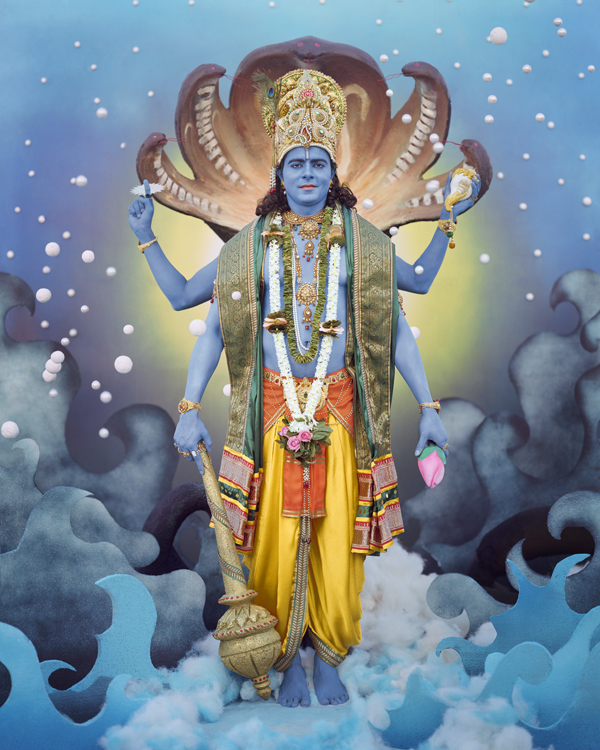
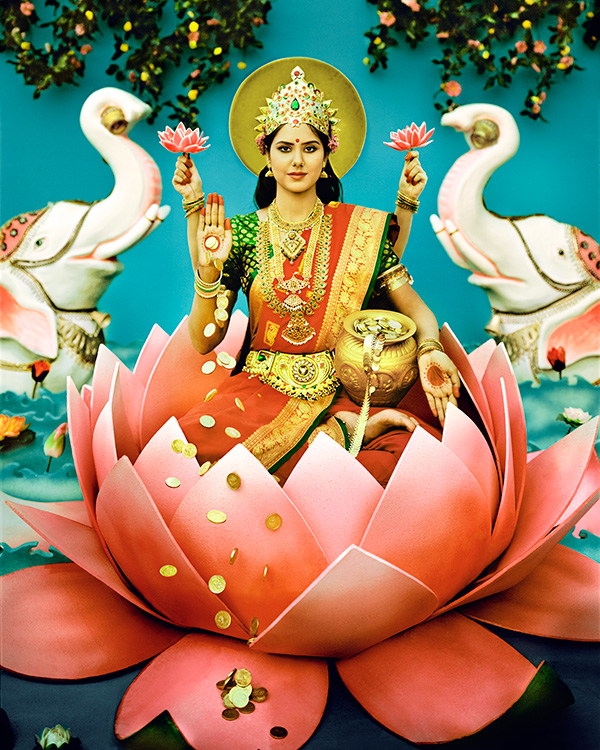
Tell me about the failed attempts. How did you start and fall flat?
I think the reason why I was failing is the reason why we all fail: I was trying to solve the problem without individualizing its answer. One size does not fit all. So, let’s talk about Maa Lakshmi for a second. She’s got elephants as her vanguards behind her shoulder, she’s sitting in a giant lotus that’s floating in water, she’s sitting in padmasana with her hands positioned a certain way, she’s got coins falling from her hand, and she’s decorated a certain way. So, there are many elements to it, obviously, which I needed to resolve one by one—Can I go find some elephant props? Is there a lotus somewhere that I can just place her in? I tried to find ready-made objects, because there’s a pretty sophisticated market of props in India. People have things sitting in their back lots after festivals and ceremonies, so I would try to track down where these objects ended up afterward. It started pretty much as a prop hunting exercise on the streets of Bombay, instead of custom-making my props. But then, when I placed her in the lotus, it was a little too small. The elephants were a little too big. It just did a disservice to her. The person needs to come before the props. These auzaars, or the things that she’s holding and the things that she’s sitting in and wearing, that’s her universe and her universe dances around her.
So, it then became very human-centric. My customized world cannot be created until my person is selected. It had to follow that order. It took a couple of attempts of renting props and trying these pictures to see that it was just not working out.
Part of the pleasure of looking at your photos is trying to figure out how it was done, but you also have a nice “making of” video that gives a glimpse into the process. It’s surprising to see how manual and physical it is, as well as how many people were involved.
Yeah, and I felt there was a magic to everybody doing a piece of it because it was already a project that was so much bigger than me. You know, I would have had to be a painter, a sculptor, a costume designer, a jewelry designer, a prop maker, a woodworker… and a photographer. But the fact is that it’s an assemblage, it’s a live collage. And the human element of it for me was a conceptual conversation, as well, because the people chosen to represent these deities were all everyday people like you and me. So, Vishnu would walk in flustered because his bus was late and he couldn’t make the set on time. And then he was working with a makeup artist, but the paint ran out. There were all of these very charming half-baked attempts to create God, you know? Here’s an entirely flawed set of people trying to make this unflawed moment come to life. It’s really just lots of flaws coming together.
So, there was a complete sense of humor to the whole situation. It was complete chaos on the set, trying to get fishing lines and lighting in place, and then this costumed human would enter the space and everything would go still for a second when the pictures was taken. Over a matter of three years, for those nine shots, the power of that stillness just grew. It took so much for all of it to come together. The photograph was just moments, but what it took to come to that moment was all the magic. And it all came down to the power of another human being looking back at me.
That’s what makes these pictures ultimately what they are—a conversation on what a darshan is and how you define it for yourself.
You could have a darshan on the summit of a mountain or on the subway. You could have a moment of supernatural connectivity anywhere at any time, but are you ready for it? Are you open to receiving it? Are you ready to be moved by it?
You write in your project description that a darshan is Sanskrit for an ‘apparition’ or a ‘glimpse’. In making this series, did you come to a conclusion or insight about what a darshan is to you?
Yes. I’ve been thinking about my art—that people want it to be this orchestrated, designed answer before it’s even born. They’ll ask, “what are you trying to do?” Well, I think I know what I’m trying to do, but I’m pulling on a thread. If I don’t pull on that thread, I’m never going to find out what I’m trying to do. I’m applying for a grant right now and they dare to ask these huge questions like, “who are you?” and “what is the relationship between your work and the universe?” It’s absurd, because I’m discovering that work by work. I’m answering the call. I am driven to create this, and I must answer that drive.
In the process of the three years that it took to make this series, I learned that I enjoy the long term process and that I’m a collaborative artist. Some people like to work alone and some like to work with the energy and connection of multiple individuals. You’re always working in concert with all these different elements, most of which are out of your control. So, another part of it is being willing to flow with the madness a little bit. To not know really where it’s going but to keep it in motion.
This project was a journey. I grew up with these stories—they were a frequent conversation with my parents—but through the series I reestablished my relationship with them. And still, I have not fully understood all aspects of them, because Hinduism is a philosophy that you can continue to mine forever.
I feel like I need to clarify that I have a big problem with many aspects of organized religion. It can be cruel and wasteful and very biased and unfair, because when it comes to the world that we humans create… well, we know how to mess things up. Let’s just put it this way. But the stories tap into your potential of what you can achieve if you’re willing to carve your own path through them. There’s a Hanuman and Kali and Vishnu within all of us, you know? It’s all untapped potential. It’s kind of like the Marvel universe told from a Hindu lens. Because they’re all such fascinating characters: They’ve all failed. They’ve all succeeded. They’ve all been banished from their kingdoms for making a mistake. They’ve been at war with each other. They’ve fallen prey to greed and jealousy. It sounds extremely human to me, honestly.
You’re from India, but have been living more than 20 years in the US. How do you think that influences you?
I’m going to be a forever advocate of both cultures because both formed me. America has a shiny image, but a really complicated relationship with itself. It’s like, “We’re so cool. Check out my kicks.” The body image and societal image and all the “keeping up with the Jones”… Unfortunately, there’s a lot of societal rot. I didn’t know that from the outside. I was definitely attracted to its shininess in India.
And in India, while I had very positive, constructive, confident parenting, I was also limited by the society. Women’s rights are poor in India, and how much you can achieve is often decided by a very patriarchal lens. Even today they’ll refer back to myth of Sita and remind you, “The Indian society didn’t even spare Maa Sita, so who are you?” At the same time, I feel like modern India is maybe one step ahead of America when it comes down to women’s reproductive rights, if you take the recent Supreme Court ruling. So, my lens is pluralistic, for sure. I’m very cognizant of wanting to retain the cultural gold I was handed growing up there for 21 years. I long for the way that spiritual discourse just flows in India. It introduces the circularity which I address a lot in my work. I constantly consider how I can fold what I’m doing back on itself.
This really shows. For example, you keep returning to water. In your early work The Shower Series, you photograph people in water, and now with your new series Surface Tension, we see you circling back to this same concept in a different way. What does water mean to you?
I feel more peace as a human being than anywhere else when I’m in covered in water. I feel the missing part of me becomes complete. It has this cleansing ability to slice through the bullshit, you know? I find I can think better in the shower and shut everything else out. And it’s very womb-like, it allows you to drown out the noise.
If I think of The Shower Series and why it exists… why should it matter to anybody that I ask somebody to come and shower and take pictures of it? It’s kind of selfish, but I feel an important aspect to being an artist is to be selfish about the things that you care about. And to selfishly want to tell those stories.
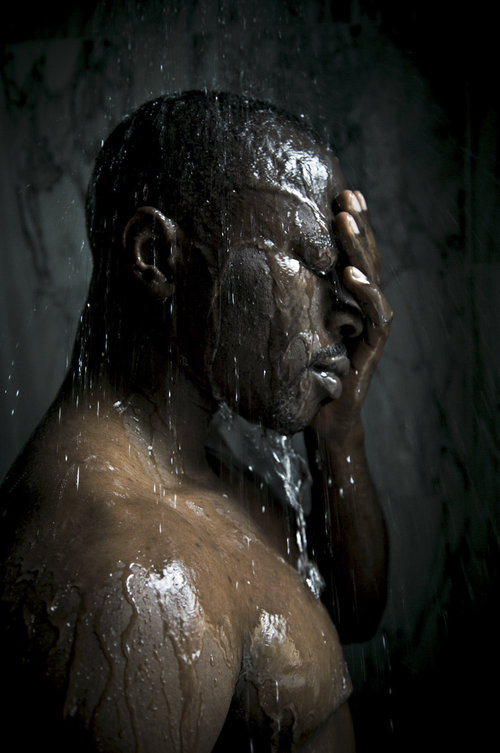
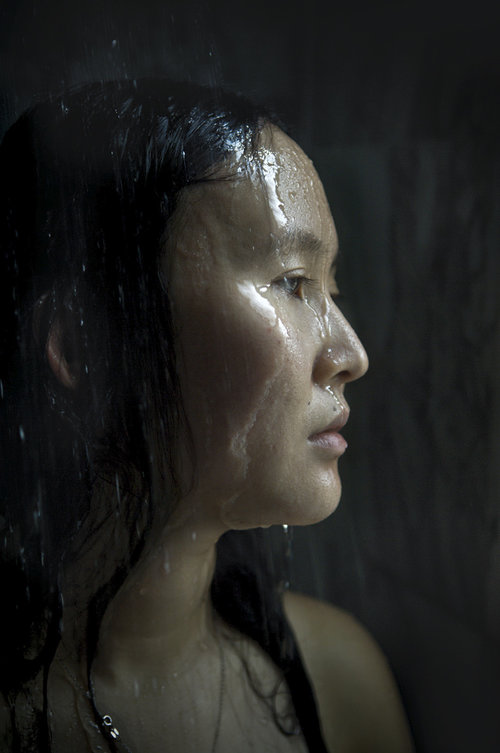
Can you elaborate on that? Why do you think an artist needs to be selfish?
I think you need to guard the flame. You need to watch your flame and tend to what it needs, because the light’s going to go out otherwise. If you don’t give it the right environment—give it burning oil, protect it from wind and so forth—then it’s going to go out. Once it’s out, you have to just sit around and wait till it gets lit again. You don’t get lit on demand. You can guard your light but you don’t get lit when you want.
Or put it another way: You can go into a rabbit hole and see what you find, but that hole appears. It may be while you’re out walking or while you’re packing your kid’s lunchbox and that hole appears in front of you… And I find myself begging, “I gotta get them to school. But please stay open. Please stay open so I can jump into it!” It’s a relationship. It’s a dance. You’ve got to keep looking for those holes… those portals of opportunity. You have to look around and be open and say, “I’m here. I’m here. I’m here. Please come to me.” It appears and then you dive in.
I actually think becoming a parent makes you guard your flame harder than you did before. Sometimes people say things like, “Oh, all the things I would have been able to achieve if I wasn’t a parent…” and that may be true. An argument could be certainly made for it. But if you’re not going to let your flame go, then you’ll learn to guard it even harder. But, I think regardless of what your circumstances are, it’s your responsibility to guard it. That’s where you have to be selfish.
How do you think becoming a mother affected your art practice?
You know, there’s a chakra in your ass—the Kundalini. Regardless of whether or not you want to connect it to that, I feel like it’s an energy portal. It’s the entry point to which things grow. When it opens up, and a child comes out of it, I feel like you get completely reconfigured. It changes your body, it changes your mind, you’ve got stuff coming out of your breasts and you just become a completely different being. How could that not have a formative impact on any human being, whether or not they consider themselves an artist?
Becoming a mother was a big awakening for me, as it is for a lot of women. You see how life is formed: This is how you come into the world, kicking, screaming, and covered in blood and body fluids. That first moment when a child wakes up and opens their eyes… it’s so magical. It was the most pain and the most joy, everything was heightened like a crescendo and an explosion of emotion in every direction, like a constellation is born, outside of you and inside of you. It’s so very dramatic and it changed me forever. It made me a more confident human being, and then it made me quickly unconfident for a lot of months because it was so hard to function. How can this be, it’s a child of 20 centimeters and my life is cracking around it?
It is a powerful time. It’s all powerfully debilitating and powerfully uplifting. It’s a pretty magical roller coaster. And yeah, I think it made me a better artist. I became more mindful about everything: resources, objects, time, what it means to value something, what is considered success or what is considered productivity. It was so productive to hold a hand, you know? It felt so fulfilling. One of the big purposes that I felt of having a child was to remember what it feels like to be a child. That was a way more innocent time, and I feel like it brings innocence back into your art. If you’ve been in the process of making art for a long time, you can lose it. The art industry can be gross. It can be a performance of who you know and all the names—it’s so tiring. Becoming a mother connected me back with my purpose.
How did your definition of success change?
I think my definition of what I would like to bring to my practice changed. I’m still defining my practice, that’s lifelong—that’s why it’s called a “practice,” not a “perfect.”
I think of my mom when she would make roti. She’d be kneading the dough and I would come in gushing with some story, and she’d stop me and say, “I need peace. I need peace right now. I’m kneading my intentions into this dough. This is going to become bread and it’s going to go inside your body. So don’t bring me anger and rage and confusion, let’s intentionally knead this dough that’s going to feed our bodies.” I think of that as a practice for my life. I need to knead with intention. Other things I can’t control, but if I keep kneading with intention, we’re going to have some tasty bread.
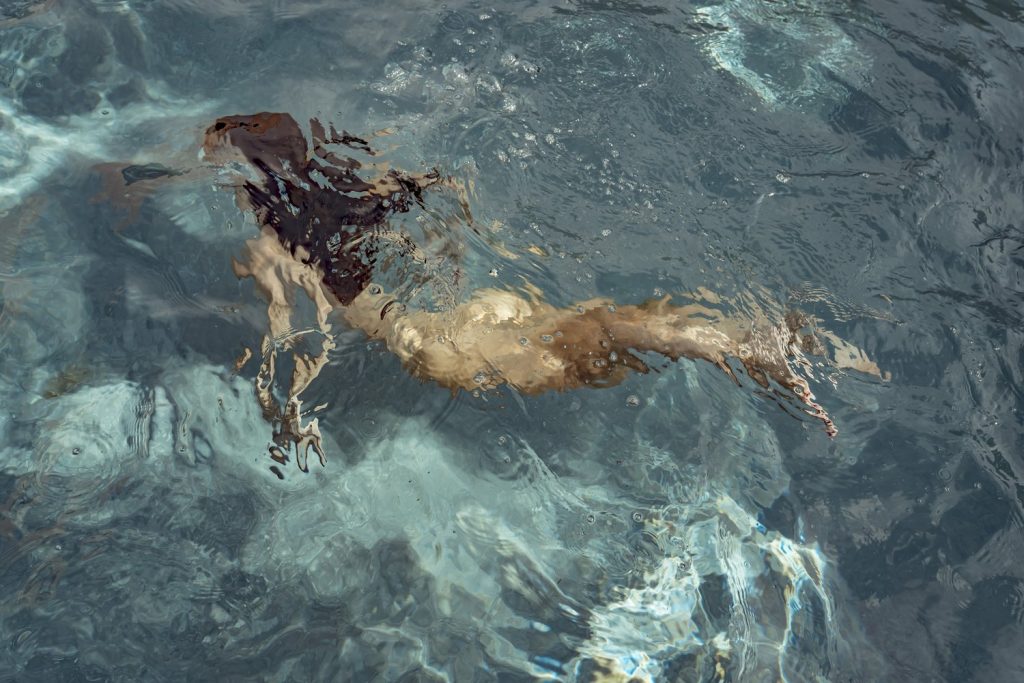
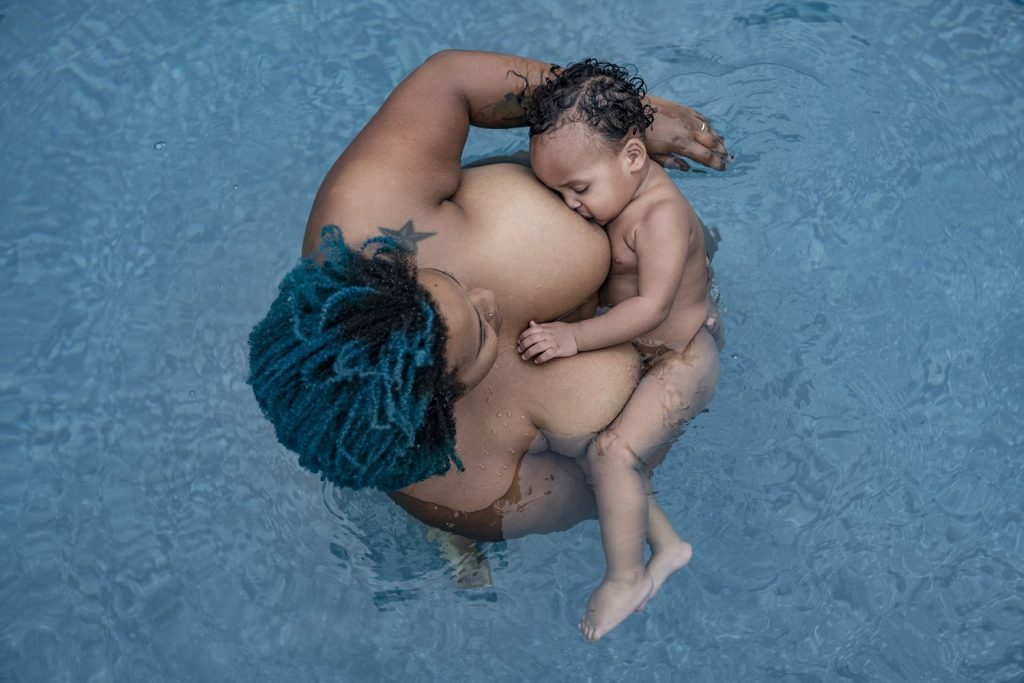
I want to come back to the way you made Darshan, which is a very elaborate, collaborative process of props and people. If I look at all your other bodies of work, they’re very different—more personal, more sensitive, less constructed and formalized. Why?
It’s a really great time to ask me this because I’m working on a 10th image for Darshan. For a long time I’ve said that I didn’t think I would make any more, but the pandemic was a really big absence of community. I missed three exhibits during the pandemic, where my work traveled but I couldn’t go. And at the same time, there was an all-time high of political polarities. You had Hindus and Muslims fighting like never before in Bombay, you had George Floyd’s death (amongst so many others) here in America… It was a difficult time. Honestly, it was a gut-tearing time as an artist. And on top of this, you couldn’t meet other humans because you might get infected by a virus. It was a pressure cooker.
That was when this vision of Narsimha came to me that I really wanted to create. Narsimha is an avatar of Vishnu, but he’s half-lion, half-man, and he comes to end injustice. He’s pictured as tearing into the gut of injustice. It’s a violent, strong, rage-filled image. That story visited me a lot over the pandemic and now it’s slated to be born in 2024.
But to come back to your question, the first time I made a Darshan after The Shower Series, people were confused, like, “Where are you going with your work?” Then, when I made the iPhone-only series, once again people were like, “What’s this turn now?” And now I’ve been making this extremely documentary-based work with my parents on their walk through dementia. I met with a curator the other day, and they suggested that I was still trying to figure out what it is that I wanted to do. Some people just want a Jackson Pollock story, of an artist who makes the one thing forever. Maybe I’ll arrive to that something that I want to stick with over and over again, but if you’ve chosen to be an artist, you’re going to march to the beat of your own drum. This is how I’m responding to my desires and I don’t know where it goes.
Yes, I wanted to ask if some people in the industry give you a hard time about that. As an editor, I personally don’t see it negatively because each of your independent works are strong enough to stand on their own, but I can imagine some take it as a lack of consistency.
There are people who completely understand it and those who don’t. You know, I didn’t sign any contract to do anything a certain way for the rest of my life. Maybe there are people who love Darshan and then don’t love the work about my mom, maybe there’s people who love my mom’s work and they don’t love the iPhone work. If you’re defining me by the tools and by the look of something, then maybe it’s missing something. If you want to read my story and understand why I’m walking the path the way I am, maybe you’ll get it. But also, you know, you don’t have to get it.
The only accountability I have is always to approach it sincerely as it comes to me. If I don’t do that, because I need to fit some kind of format for the world, then I’m going to probably die a very sad death. And maybe the next flame that comes up I won’t have any interest in guarding.
My favorite part of my practice is discovering something new in every series. And if I do something that looks like the last time around, it doesn’t energize me. I think that this Narsimha is going to be a very different deity than the nine earlier deities, because I’m not the same Manjari as when I started Darshan. It’s like saying you’re not allowed to evolve in your explorations. I really can’t speak to anybody else’s method, but I can say that what brings me the most joy is discovering a new path with a new project.
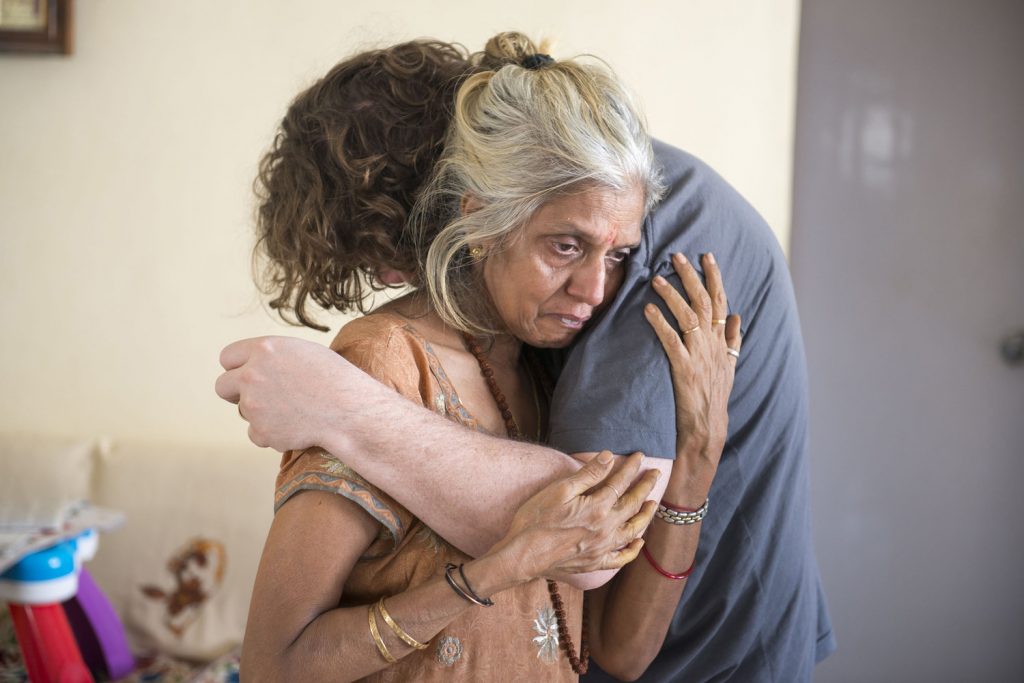
You’ve just joined the relatively young agency Assembly. How do you think that approach will work in the context of representation?
I just had a commission with Patagonia to photograph protests, which was a very straight photographic documentation. Now, with the Surface Tension work, as you can probably see from the series that’s already on the website, I’ve been doing much more exploration like with video projections into the pool. So I don’t feel particularly bound. I consider myself an artist exploring mediums that help me tell my story. I have people who are believers of individual projects, and sometimes multiple, but it’s a question of subject matter. I think I’m united in my content. I feel like I’m telling the same story over and over again, which is one of hope. My story in every case is about circularity, and about bringing a pluralistic lens to things. So, the person who wants to represent me is going to be interested in me, and in my long term interest in telling stories with the sensitivity and complexity that I can bring to it because of the person that I am. I think that we’re all hyphenates in that sense.
I’ve got one life to live and I’m going to be holistically approaching all of my interests. And maybe some of them will sell better than others, or be better suited for somebody’s wall or as a book, but my job is to listen to what’s ticking within me.
You mentioned hope as a unifying theme. What are you currently hopeful about?
My hope comes from our belief in each other. I think that we can achieve anything we want if we can trust each other. We have to trust that we’ve been hurt. We have to listen to each other about the things that we’ve been hurt about. Listen more in general. My ultimate goal is to uplift someone, either because my work is about things that matter to them, or that they receive something from the work that makes them feel seen. That would mean, for me, that the work has done something.
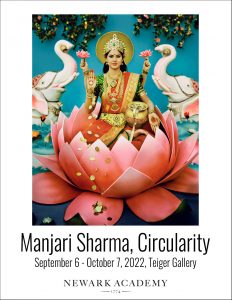 See more of Manjari Sharma’s work on her website, or through her agency Assembly. An exhibit of her work, CIRCULARITY, is on display from Sept 6 – Oct 7, 2022 at the Teiger Gallery of Newark Academy. Her work Darshan is also on display at the Birmingham Museum of Art from Mar 19, 2022 – Jan 15, 2023, which was reviewed on the Wall Street Journal, and has a catalogue available.
See more of Manjari Sharma’s work on her website, or through her agency Assembly. An exhibit of her work, CIRCULARITY, is on display from Sept 6 – Oct 7, 2022 at the Teiger Gallery of Newark Academy. Her work Darshan is also on display at the Birmingham Museum of Art from Mar 19, 2022 – Jan 15, 2023, which was reviewed on the Wall Street Journal, and has a catalogue available.

